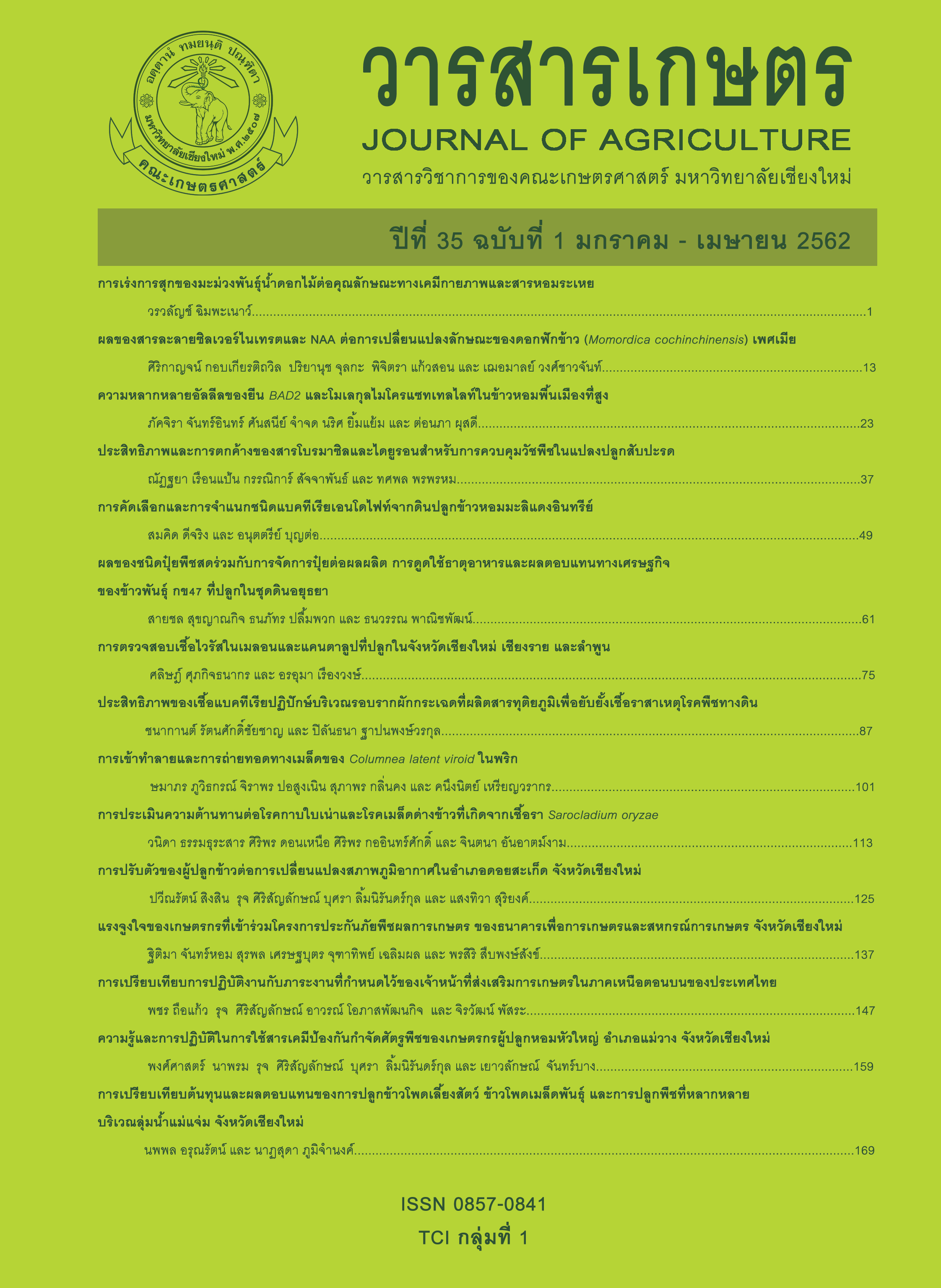Efficiency of Antagonistic Rhizobacteria from <I>Neptunia natans</I> and Their Secondary Metabolites Against Soil-borne Plant Pathogenic Fungi
Main Article Content
Abstract
This study aims to select potential rhizobacteria from Neptunia natans to inhibit mycelial growth of soil-borne pathogens such as Sclerotium rolfsii, Rhizoctonia solani, Pythium sp. and Fusarium oxysporum which cause root and stem rot disease in lettuce. Using dual culture and volatilization by sealed plate method, the results showed that four soil-borne phytopathogenic fungi were significantly inhibited by ten isolates of rhizobacteria, R1016, R1029, R1033, R1036, J3002, Rr4007, Rr4053, Rr4058, Rr4082 and Rr4084 (P<0.05). These isolates exhibited high percentage of mycelial growth inhibition at 75-100% for S. rolfsii and Pythium sp., 53-57% for R. solani, and 12% for F. oxysporum. Moreover, the volatiles produced by the rhizobacteria induced qualitative morphological abnormalities, such as lysis and degradation of fungal structures and quantitative effects of fungal growth on potato dextrose agar (PDA). The result suggested that antagonistic rhizobacteria had antifungal activities against a wide spectrum of soil-borne fungal pathogens. Five rhizobacteria isolates, R1033, Rr4053, Rr4058, Rr4082 and Rr4084, completely inhibited mycelial growth of S. rolfsii. When mycelial plugs were transferred to fresh PDA agar plates, the pathogen could not grow, and some rhizobacteria can also produce secondary metabolites, suggesting their potential role in biological control. This study contributes to understanding the use of antifungal volatiles in suppression of root and stem rot disease and promote growth of plant.
Article Details
References
ปิลันธนา ฐาปนพงษ์วรกุล และ ชนากานต์ รัตนศักดิ์ชัย-ชาญ. 2559. ประสิทธิภาพของน้ำสกัดชีวภาพจากเศษเหลือพริกต่อการยับยั้งเชื้อรา Colletotrichum gloeosporioides ในสภาพห้องปฏิบัติการ. วารสารเกษตร 32(1): 61-72.
ปิลันธนา ฐาปนพงษ์วรกุล และ ศราวิชญ์ สายมงคล. 2558. ประสิทธิภาพของเชื้อแบคทีเรียปฏิปักษ์ Bacillus megaterium สายพันธ์ No.16 ในการควบคุมโรคกาบใบแห้งของข้าวพันธุ์ กข6. วารสารเกษตร 31(3): 301-310.
มานะ กาญจนมณีเสถียร อัจฉรา เพ็งหนู ฤดีกร วิวัฒน-ปัฐพี และ วานิด รอดเนียม. 2556. การคัดเลือกแบคทีเรียปฏิปักษ์และการพัฒนาผลิตภัณฑ์แบคทีเรียปฏิปักษ์เพื่อควบคุมโรคพืชที่ปลูกในระบบไฮโดรโพนิกส์. สถาบันวิจัยและพัฒนามหาวิทยาลัยศิลปากร, นครปฐม. 58 หน้า.
Agrios, G.N. 2005. Plant Pathology. 5th ed. Academic Press, New York. 592 p.
Alstrom, S. 2001. Characteristics of bacteria from oilseed rape in relation to their biocontrol activity against Verticillium dahliae. Journal of Plant Pathology 149(2): 57-64.
Antoun, H., C.J. Beauchamp, N. Goussard, R. Chabot and R. Lalande. 1998. Potential of Rhizobium and Bradyrhizobium species as plant growth promoting rhizobacteria on non-legumes: Effect on radishes (Raphanus sativus L.). Plant and Soil 204(1): 57-67.
Arfaoui, A., B. Sifi, A. Boudabous, I.E. Hadrami and M. Chérif. 2006. Identification of Rhizobium isolates possessing antagonistic activity against Fusarium oxysporum f. sp. ciceris, The causal agent of fusarium wilt of chickpea. Journal of Plant Pathology 88(1): 67-75.
Astrom, B. and B. Gerhardson. 1988. Differential reactions of wheat and pea genotypes to root inoculation with growth-affecting rhizosphere bacteria. Plant and Soil 109(2): 263-269.
Bardin, S.D., H.C. Huang, J. Pinto, E.J. Amundsen and R.S. Erickson. 2004. Biological control of Pythium damping-off of pea and sugar beet by Rhizobium leguminosarum bv. viceae. Canadian Journal of Botany 82(3): 291-296.
Bhatia, S., R.C. Dubey and D.K. Maheshwari. 2005. Enhancement of plant growth and suppression of collar rot of sunflower caused by Sclerotium rolfsii through fluorescent Pseudomonas. Indian Phytopathology 58(1): 17-24.
Burr, T.J., B.H. Katz, A.L. Bishop, C.A. Meyers and V.L. Mittak. 1988. Effect of shoot age and tip culture propagation of grapes on systemic infestations by Agrobacterium tumefaciens biovar 3. American Journal of Enology and Viticulture 39: 67-70.
Calvo, P., E. Ormeño-Orrillo, E. Martínez-Romero and D. Zúñiga. 2010. Characterization of Bacillus isolates of potato rhizosphere from Andean soils of Peru and their potential PGPR characteristics. Brazilian Journal of Microbiology 41(4): 899-906.
Chaurasia, B., A. Pandey, L.M. S. Palni, P. Trivedi, B. Kumar and N. Colvin. 2005. Diffusible and volatile compounds produced by an antagonistic Bacillus subtilis strain cause structural deformations in pathogenic fungi in vitro. Microbiological Research 160(1): 75-81.
Deshwal, V.K., P. Pandey, S.C. Kang and D.K. Maheshwari. 2003. Rhizobia as a biological control agent against soil borne plant pathogenic fungi. Indian Journal of Experimental Biology 41(10): 1160-1164.
Ekman, J., L. Tesoriero and S. Grigg. 2014. Pests, Diseases and Disorders of Babyleaf Vegetables: A Field Identification Guide. Applied Horticultural Research, New South Wales.114 p.
Fernando, W.G.D. and R.G. Linderman. 1995. Inhibition of Phytophthora vignae and stem and root rot of cowpea by soil bacteria. Biological Agriculture and Horticulture 12(1): 1-14.
Fiddaman, P.J. and S. Rossall. 1993. The production of antifungal volatiles by Bacillus subtilis. Journal of Applied Microbiology 74(2): 119-126.
Fiddaman, P.J. and S. Rossall. 1994. Effect of substrate on the production of antifungal volatiles from Bacillus subtilis. Journal of Applied Microbiology 76(4): 395-405.
Harman, G.E., C.R. Howell, A. Viterbo, I. Chet and M. Lorito. 2004. Trichoderma species: opportunistic, avirulent plant symbionts. Nature Reviews Microbiology 2(1): 43-56.
Homma, Y., Z. Sato, F. Hirayama, K. Konno, H. Shirahama and T. Suzui. 1989. Production of antibiotics by Pseudomonas cepacia as an agent for biological control of soilborne plant pathogens. Soil Biology and Biochemistry 21(5): 723-728.
Kai, M., U. Effmert, G. Berg and B. Piechulla. 2007. Volatiles of bacterial antagonists inhibit mycelial growth of the plant pathogen Rhizoctonia solani. Archives of Microbiology 187(5): 351-360.
Khianngam, S., Y. Pootaeng-on, T. Techakriengkrai and S. Tanasupawat. 2014. Screening and identification of cellulase producing bacteria isolated from oil palm meal. Journal of Applied Pharmaceutical Science 4(4): 090-096.
Kurze, S., H. Bahl, R. Dahl and G. Berg. 2001. Biological control of fungal strawberry diseases by Serratia plymuthica HRO-C48. Plant Disease 85(5): 529-534.
Nelson, E.B., W.L. Chao, J.M. Norton, G.T. Nash and G.E. Harman. 1986. Attachment of Enterobacter cloacae to hyphae of Pythium ultimum: possible role in the biological control of Pythium preemergence damping-off. Phytopathology 76(3): 327-335.
Richard, N.R. 2004. Lettuce diseases and their management. pp. 121-147. In: S.A.M.H. Naqvi (ed.). Diseases of Fruits and Vegetables. Vol. 2. Springer, Dordrecht.
Tenorio-Salgado, S., R. Tinoco, R. Vazquez-Duhalt, J. Caballero-Mellado and E. Perez-Rueda. 2013. Identification of volatile compounds produced by the bacterium Burkholderia tropica that inhibit the growth of fungal pathogens. Bioengineered 4(4): 236-243.
Van Loon, L.C., P.A.H.M. Bakker and C.M.J. Pieterse. 1998. Systemic resistance induced by rhizosphere bacteria. Annual Review of Phytopathology 36: 453-483.
Wheatley, R.E. 2002. The consequences of volatile organic compound mediated bacterial and fungal interactions. Antonie Van Leeuwenhoek 81: 357-364.


